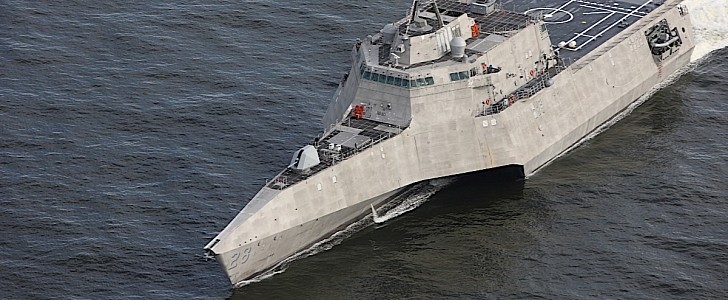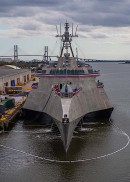From coastal galleys to oilers, there have been so far five ships named in honor of the city of Savannah, Georgia, serving American needs and interests since the late 1700s. The sixth, a littoral combat ship, joined the ranks over the weekend in Brunswick, Georgia.
LCS 28 by its code name, the new USS Savannah is an Independence-class ship, the 14th of its kind to be enlisted by the U.S. Navy as part of its modernization efforts.
It was designed as a rather small (a little over 2,500 tons displacement) and fast (it is powered by a combination of turbines, diesel engines, and generators that give it a top speed of 51 mph/81 kph) warship. It is capable “to operate in near-shore environments while capable of open-ocean tasking,” performing missions of “forward presence, maritime security, sea control, and deterrence.”
The LCS 28 will be joining a fleet comprising 14 others of its kind, the most recent being the USS Oakland and USS Canberra, both commissioned last year.
As for the name chosen for it, it started being used in 1798 on a galley that defended the coastline. It was then slapped onto a frigate, the flagship of the Pacific Squadron in the mid-1800s.
The third Savannah was actually born as a German commercial freighter called Saxonia. It was seized by Americans at the start of World War I, rechristened and converted into a submarine tender.
Savannah number four was a Brooklyn-class light cruiser that served in the Mediterranean during World War II, receiving three battle stars for its service. The last one was a Wichita-class replenishment oiler born in the 1970s.
In between them, Savannah-named ships have served in five of humanity’s most high-profile conflicts: the Mexican War, the Civil War, World War I, World War II, and the Vietnam War.
It was designed as a rather small (a little over 2,500 tons displacement) and fast (it is powered by a combination of turbines, diesel engines, and generators that give it a top speed of 51 mph/81 kph) warship. It is capable “to operate in near-shore environments while capable of open-ocean tasking,” performing missions of “forward presence, maritime security, sea control, and deterrence.”
The LCS 28 will be joining a fleet comprising 14 others of its kind, the most recent being the USS Oakland and USS Canberra, both commissioned last year.
As for the name chosen for it, it started being used in 1798 on a galley that defended the coastline. It was then slapped onto a frigate, the flagship of the Pacific Squadron in the mid-1800s.
The third Savannah was actually born as a German commercial freighter called Saxonia. It was seized by Americans at the start of World War I, rechristened and converted into a submarine tender.
Savannah number four was a Brooklyn-class light cruiser that served in the Mediterranean during World War II, receiving three battle stars for its service. The last one was a Wichita-class replenishment oiler born in the 1970s.
In between them, Savannah-named ships have served in five of humanity’s most high-profile conflicts: the Mexican War, the Civil War, World War I, World War II, and the Vietnam War.






